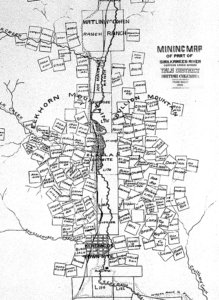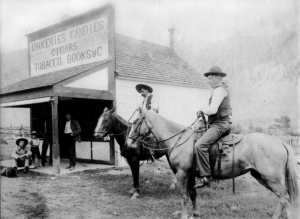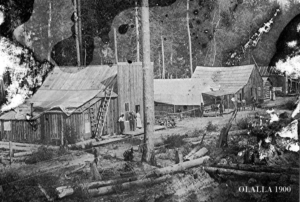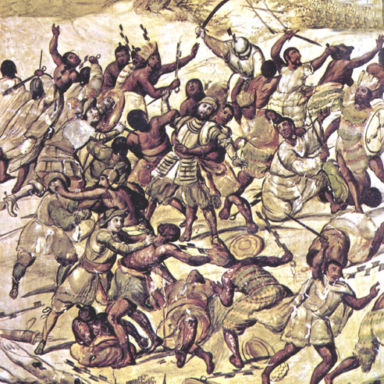 James Riorden was a rancher from Olalla. He was also one of the original 18 men who staked claims at Hedley Camp in 1895. Today, a mountain at Apex Alpine area is named in his honor.
James Riorden was a rancher from Olalla. He was also one of the original 18 men who staked claims at Hedley Camp in 1895. Today, a mountain at Apex Alpine area is named in his honor.
James had a feeling that the vein of gold, silver, copper, lead and zinc at Hedley Camp would pop up in other areas to the east. He registered several claims at Apex Lake that proved very lucrative.
The name “Olalla” is a derivative of the Chinook word “Olallie”, the local name for Saskatoon

berries. The area was a popular hunting area for Similkameen Natives and the creek helped operate the early grist mill for those growing grains. Locals were startled by the hundreds of prospectors crawling over the hillsides at the turn of the century.
There was little for those passing through and the closest civilization was Upper Keremeos and even there provisions were sparse. Before L.A. Clark was commissioned to build a road from Penticton to Nickle Plate Mine, all provisions came by wagon from across the border at Republic, Washington. The closest Government registry was at Fairview, quite an arduous trek from Olalla. Claims were commonly “jumped” by those registering before the true owner could make it to the Gold Commissioner’s office.
With several hundred miners squatting on the flats near the mouth of Olalla Creek, it wasn’t long before a few buildings went up. Mr. Pritchard, a Keremeos farmer, opened a store in 1900. Soon after he became postmaster as well. Local rancher,
Keremeos farmer, opened a store in 1900. Soon after he became postmaster as well. Local rancher,
Emanuel Barcelo, had opened a hotel at Upper Keremeos, but it was constantly at maximum tenancy. So Prichard built a small hotel as well, to cash in on the arrival of those with money.
But as all gold rushes go, this one went and most miners left. Prichard managed to keep the post office open until 1912, then all went to Central Keremeos on the freight road and to Lower Keremeos to the railroad.
Several surveys for railways were done in the years up to 1900. The map shown here has a proposed Columbia and Western Railroad through Olalla and Keremeos. This spur to Penticton was part of the Great Northern survey of Jim Hill’s empire to haul minerals to smelters in the east.
Some of the claims on the upper creek showed good returns, particularly Sunrise, Sweetner, Shepard, Powder and Hedley Monarch. But they were never to the extent of Camp Hedley claims. It was very labour intensive to remove the metals from the hard base rock. This caused a lot of early claims to be sold to the larger companies and the miners wandered off to other gold strikes.
One of the successful corporations to continue in Olalla was Gold Valley Mines Ltd. It continued to mine the Sunrise and Shepard claims acquired in 1935. It was successful in grading 18.41 grams of gold per tonne and 17.44 grams of silver per tonne from new shafts. For 1948, the company recovered 3763 grams of silver, 4261 grams of gold and 209 kilograms of copper. The mine closed that year and the company changed hands often until acquired by Goldcliff Resources Corp. who holds the mines in Olalla today.

